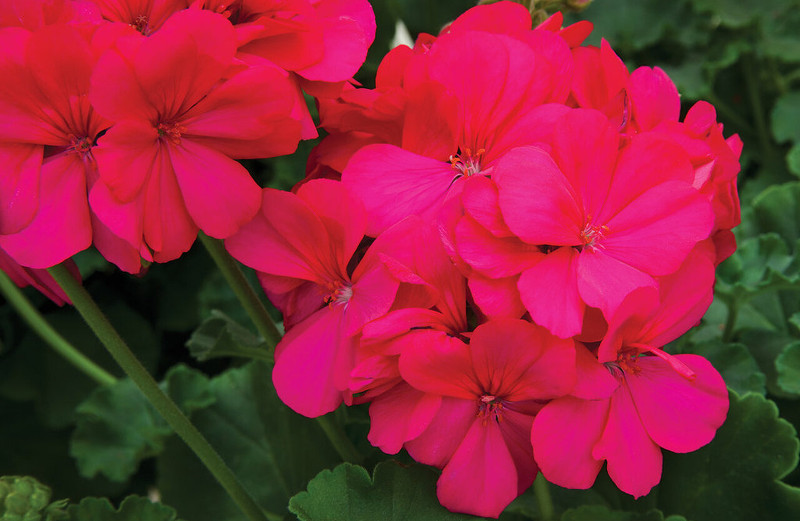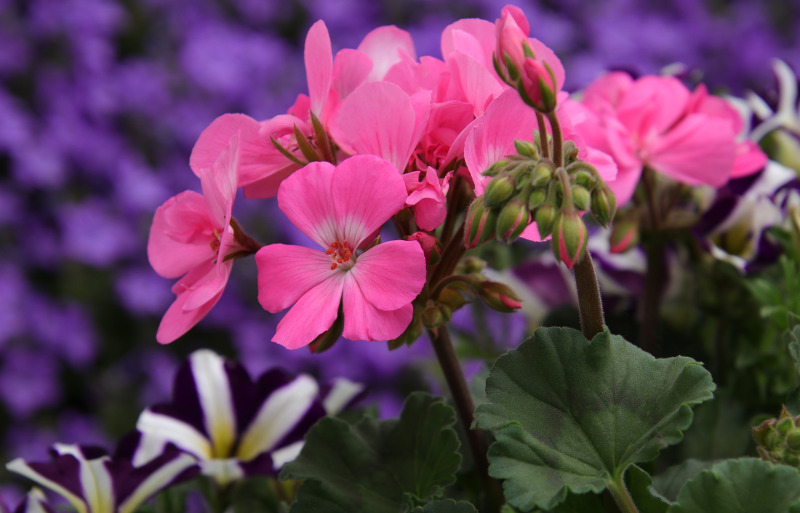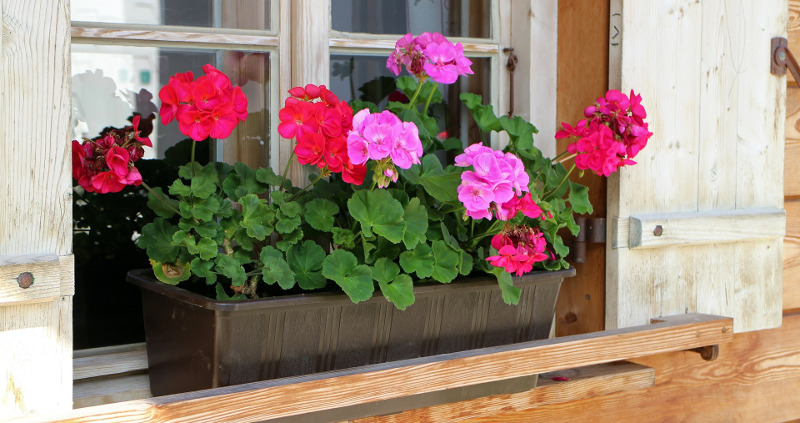Pelargonium is a genus of flowering plants which includes about 280 species of perennials, succulents, and shrubs, commonly known as Geraniums or Storksbill. Geranium is also the botanical name and common name of a separate genus of related plants, also known as Cranesbills. We mainly sell Pelargoniums.
Hardy in USDA zones 9-12, this plant is considered an annual in most parts of the United States. Stunning colors of red, purple, pink, magenta orange, salmon, white, and bicolors, Geraniums can be grown as a colorful houseplant as well. Growing anywhere from 5-36 inches tall, Geraniums grow the best in full sun. Most gardeners plant Geraniums in cottage gardens or in a container.

Planting Geraniums
Geraniums can be grown as houseplants or annual flowers. This plant blooms from mid spring until the first frost. Plant in rich well-drained soil in a location that will get full sun with partial afternoon shade. Typically drought tolerant, water geraniums every few days when the soil is completely dry. Usually not heavy feeders, container grown Geraniums will benefit from an application of fertilizer every 2-4 weeks. Pelargonium are toxic to animals, including dogs, cats, and horses
Watering Geraniums
Geraniums will grow better when the soil completely dries out between waterings. Excellent drainage is a must, so choose a well draining soil. It is best to water deeply and thoroughly, allowing the soil to dry out before watering again. Water at the base of the plant, avoiding the foliage.
Overwatered geraniums will develop yellow drooping leaves and wilted blossoms. Stop watering and allow the soil to completely dry out. Container grown Geraniums will require more frequent waterings.

Fertilizing Geraniums
Geraniums can be grown both indoors and outdoors. In general, this plant has low fertilizer requirements. The nutritional requirements for indoor and outdoor geraniums differ. Houseplant geraniums require very little fertilizer.
For established geraniums, use a water-soluble 20-20-20 formula at a rate of 2 tablespoon to one gallon of water every 4-6 weeks. During the winter, it is every 8 weeks. Outdoor geraniums can be fertilized at planting and again in July at half the original rate. Overfertilizing will result in poor blooming.
Pruning Geraniums
Annual geraniums do not require pruning, but regular deadheading is beneficial. Trimming the plant encourages new growth and prevents disease. This will also increase flower production. Pinch off any dead leaves and flower stalks after the flower fades. If the plant looks long legged and thin, pinch off some stalks at the growing point. This will encourage new branch growth and more blooms.

Caring For Geraniums in Pots
Geraniums actually thrive when grown in containers. Plant in well-drained potting soil, as geraniums do not like soggy compacted soil. Be sure that the container has drainage holes to help prevent root rot. Place the container in a location that will get 4-6 hours of sun each day. Geraniums will bloom better with more sun. During the cold weather months, move the container inside and treat the geranium as a houseplant.

Winter Care for Geraniums
Container Geraniums that have been outdoors for the summer can be kept indoor to overwinter. In fact, if provided with enough sunlight, they will bloom year round. Prior to bringing the container indoors, trim the plant of any dead plant material and inspect for pests.
Place the container in a sunny location. Water only when the soil feels dry. During the winter, pinch the growing tips of the plants a few times. This will help to promote growth.
Geraniums For Sale
Common Geranium Care Questions
Are Geraniums Annuals Or Perennials?
The answer to that is, yes! True geraniums (hardy geraniums or cranesbills) are perennials and generally hardy in zones 5-8. These are often confused with "scented geraniums (Pelargoniums) which are more common, only hardy in zones 10-11, but boast showier, more plentiful blooms. However, they're relatively easy to overwinter indoors.
What Makes Holes In Geranium Leaves?
The most common culprit of holes in geranium leaves is the tobacco budworm, little brown, green, or red worms, and they have a white stripe running the full length of their bodies and are about 1.5 inches long. The most budget-friendly to rid your geraniums of these pests is to find them at dusk, while they're actively feeding, and remove them.
Do Geraniums Spread?
Geraniums don't spread, but they are easily propagated with stem cuttings.
Why Do Geranium Leaves Turn Yellow?
Yellow leaves on geranium are usually due to under-watering causing the plant to be dehydrated.
Do Geraniums Prefer Sun Or Shade?
Geranium loves the sun and does best with at least 4-6 hours of direct sunlight a day, more if the light is filtered. The more sun, the more prolific the blooms.
Do Geraniums Come Back Every Year?
True geraniums are perennials in some warmer regions, but the much more commonly grown scented geraniums are annuals, but are easily over-wintered and can even be grown in the house as a house plant.
How Tall Do Geraniums Grow?
There are many varieties of geraniums and they can range in height from 6 to 48 inches.
What Is The Growth Rate Of Geranium?
Geraniums are fast growers, some varieties can grow a spread of up to 5 or 6 feet in a single season.
Are Geraniums Drought Tolerant?
Scented geraniums are very drought tolerant and while they love the sun, some shade in the hottest part of the afternoon isn't a bad thing. Over-watering is a much more frequent problem for geraniums than drought.
Why Do Geranium Leaves Turn Brown?
Brown leaves on geraniums can be a sign of a fungal infection and root rot. The likely cause is over-watering and/or poorly draining soil.
Have a question about Geraniums? Fill out the form below and we will try and get back to your question as soon as possible. We may even feature your question on this article to help other gardeners!
 |
Author Chris Link - Published 07-23-2021 |
